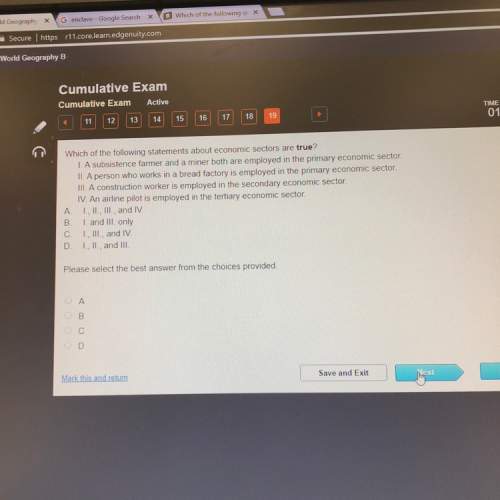
Geography, 25.07.2019 03:20 jacycooley
34. how long does a complete precession cycle take? a) 60,000 years b) 26,000 years c) 6000 years d) 4 years 35. how many astronomical units are there between the earth and sun? a) one b) ten c) one million d) six trillion 36. what was one of the contributions made by copernicus to astronomy? a) he discovered that the planets move around the sun in elliptical orbits, b) he said that the earth is not the center of the universe. c) he developed a theory of gravity that could explain orbital motion. d) he used a telescope to observe the heavens, thereby reinforcing the notion of heliocentricity e) he made extensive and detailed observations of the positions of the planets. 37. what contribution to astronomy was made by tycho brahe? a) he discovered that the planets move around the sun in elliptical orbits. b) he said that the earth is not at the center of the universe. c) he used a telescope to observe the heavens, thereby reinforcing the notion of heliocentricity. d) he made extensive and detailed observations of the positions of the planets. e) he developed a theory of gravity that could explain orbital motion. 38. what was one of the contributions made to astronomy by joannes kepler? a) he discovered that the planets move around the sun in elliptical orbits. b) he developed a theory of gravity that could explain orbital motion. c) he said that the earth is not at the center of the universe. d) he used a telescope to observe the heavens, thereby reinforcing the notion of heliocentricity. e) he made extensive and detailed observations of the positions of planets. 39. what was one of newton's contributions to astronomy? a) he discovered that the planets move around the sun in elliptical orbits. b) he developed a theory of gravity that could explain orbital motion. c) he said that the earth is not at the center of the universe. d) he used a telescope to observe the heavens, thereby reinforcing the notion of heliocentricity e) he mad extensive and detailed observations of the positions of planets. 40. the force of gravity between two objects: a) increases with the mass of the objects and decreases with the distance between them. b) decreases with the mass of the objects and increases with the distance between them. c) increases with the mass of the objects and the distance between them. d) decreases with the mass of the objects and the distance between them.

Answers: 2


Another question on Geography

Geography, 21.06.2019 12:30
Shaken by the collapse of the steel industry, which had provided them with an unshakable sense of identity for more than a century, pittsburghers hunkered down and built a new economy based on services, medicine, education, and technology. in the process, they transformed their community from one driven by quantity of production into one devoted to quality of life. —peter miller, "pittsburgh: stronger than steel," national geographic, december 1991. the community remodeling carried out in pittsburgh was accomplished partly through the conversion of old factories for new uses—a process known as a. urban renewal. c. gentrification. b. retooling. d. urban pioneering.
Answers: 2

Geography, 22.06.2019 09:20
Acounterculture is composed of a group of people who the dominant culture.
Answers: 1

Geography, 23.06.2019 14:00
Uncle tom's cabin started out as a series of articles printed in the national era, a newspaper.
Answers: 1

Geography, 23.06.2019 15:20
All of the following actions are examples of civil disobedience, except a.) refusing to pay an unfair tax b.) refusing to use government services c.) participating in a protest march d.)planning a riot to destroy a government riot
Answers: 1
You know the right answer?
34. how long does a complete precession cycle take? a) 60,000 years b) 26,000 years c) 6000 years d...
Questions




Mathematics, 07.04.2021 17:10





Mathematics, 07.04.2021 17:10

World Languages, 07.04.2021 17:10


Mathematics, 07.04.2021 17:10


History, 07.04.2021 17:10

Social Studies, 07.04.2021 17:10

Geography, 07.04.2021 17:10

Mathematics, 07.04.2021 17:10

Mathematics, 07.04.2021 17:10

Mathematics, 07.04.2021 17:10





